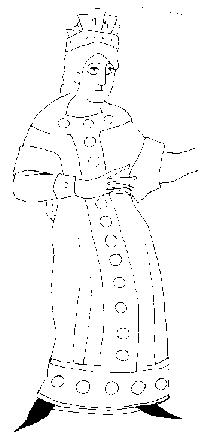
|

|

|
(image of garment worn)
The garment was made for a Royal Visit. The garment was designed based on images in Gale Owen-Crocker's "Dress in Anglo-Saxon Britain".
"Gowns are, however, very much in evidence in the Stuttgart Psalter, both showing beneath the cloak and at the aperture. (Figs 87,88, 90), and being worn without the covering cloak (Fig. 89). They are ankle-length, and have fairly wide sleeves reaching to about the elbow, revealing the tighter sleeves of an undergarment. Wide bands of ornament decorate hem, front and neckline. There are no visible fasteners. Presumably the garment was put on over the head."
From "Dress in Anglo-Saxon England" by Gale Owen-Crocker, pp99-100, chapter concerning Women's costume 7th -- 9th centuries.

|

|

|
Figures from the Stuttgart psalter, Wuertembergische Landesmuseum MS Biblia
fols 94V, 57V, 58, after Owen-Crocker
Material
The gown is made from a dark blue, twill wool. It is rather loosely woven, and has only been lightly fulled. It is lined with light blue cotton - I was unable to find a blue linen, and did not have time to dye some linen with woad before I needed the gown.
(photo of the gown with lining showing)
The gown is cut in one piece. The construction is the part I am the least happy with in retrospect: when I sewed it, I had not yet learned about the efficient cutting of garments, and while a more period cut would not have used less fabric, I would have had a more authentic look. It was cut, interlined under the embroidery, the embroidery done, then sewed up and lined. The pearls and beads were sewn on last, after the garment was lined. That was simply a choice made to avoid putting the pearls through the sewing machine.
The design of the embroidery is my own, created after looking at pictures of similar garments (see above), reading of embroidery in Owen-Crocker and Dodwell, and studying the Maaseik embroideries. The sort of sinewy, scrolling pattern that can be found in the arcade strips on the Casula, ending in trefoils, was similar to things I had seen on carvings and manuscripts, and it seemed an attractive and appropriate style for my gown.
(picture of Maaseik)
The embroidery was done with marlitt floss. The gown was one of the earliest I have done, and I had been told to avoid silk because 'it twists and tears and fuzzes'. The same person recommended I use marlitt instead. Now that I have worked in both materials, I vow I will never touch marlitt again. It was horrendous to work with, and while it looks good once it is on, the time it took to get it finished was probably twice as long as it would have taken using silk.
The outline is done in a metal thread - very fine 'jap' gold. Inside the scrolls are little rosettes made of pearls and gold beads. The Maaseik embroideries were embellished with pearls, although there is a theory that these were added later, possibly in the 9th C, possibly later. However, when the embroidery was done, I felt it needed something inside the scrolls, and Dodwell writes: "The garments of both women and men were ornamented with gold work and sometimes with jewels."
The embroidery consists of row upon row of stem stitch. The leaf shapes were filled in from the outside to ensure good coverage.
(close-ups of the embroidery)
Gale R. Owen-Crocker: Dress in Anglo-Saxon England. Manchester 1986.
Mildred Budny and Dominic Tweddle: The Maaseik Embroideries. In Anglo-Saxon England, volume 13 1984
C. R. Dodwell: Anglo-Saxon Art, a new perspective. Manchester 1982.